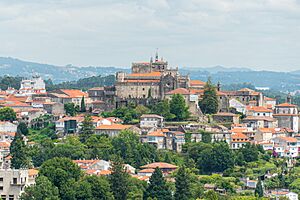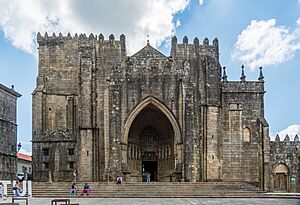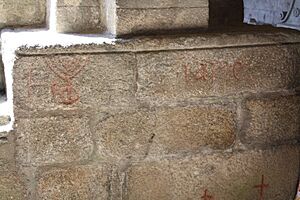Tui, Pontevedra facts for kids
Quick facts for kids
Tui
|
|||
|---|---|---|---|

View as seen from Portugal.
|
|||
|
|||
| Country | |||
| Autonomous Community | |||
| Province | Pontevedra | ||
| Comarca | O Baixo Miño | ||
| Parroquias |
List
Areas
Baldráns Caldelas de Tui Guillarei Malvas Paramos Pazos de Reis Pexegueiro Randufe Rebordáns Ribadelouro Tui |
||
| Government | |||
| • Type | Concello | ||
| Area | |||
| • Total | 68.3 km2 (26.4 sq mi) | ||
| Elevation | 44 m (144 ft) | ||
| Population
(2018)
|
|||
| • Total | 16,902 | ||
| • Density | 247.47/km2 (640.9/sq mi) | ||
| Time zone | UTC+1 (CET) | ||
| • Summer (DST) | UTC+2 (CET) | ||
| Post code |
36700
|
||
| Area code(s) | +34 986 | ||
Tui is a historic town in Galicia, Spain. It is located in the Pontevedra province, right next to the Miño River. The town faces Valença, a Portuguese town across the river. Tui is part of the O Baixo Miño area.
The municipality of Tui includes 11 smaller areas called parishes. These are Randufe, Malvas, Pexegueiro, Areas, Pazos de Reis, Rebordáns, Ribadelouro, Guillarei, Paramos, Baldráns, and Caldelas.
Two bridges connect Tui with Valença in Portugal. The Tui International Bridge, also known as the "Friendship Bridge," was finished in 1878. A newer bridge was built in the 1990s. Since both Spain and Portugal are part of the Schengen Treaty, people can usually cross the border easily. This is the busiest border crossing in northern Portugal.
Contents
Tui's Long History
Tui has a very long and interesting history, with people living there for thousands of years.
Ancient Times in Tui
People have lived in the Tui area since prehistoric times. Scientists found evidence of early human life during the building of the Vigo-Tui highway. These findings date back to the Lower Paleolithic period, around 20,000 BC. This makes them the oldest human sites found in Galicia.
The rich land near the Miño River was perfect for early settlements. Tools from the Neolithic period (around 5,000 BC) have been found, like the Carrasqueira ax. Large stone monuments called megaliths, like the Anta in Areas, also show ancient human activity. When people started using metals around 4,000 BC, they left behind items like a bronze helmet and axes from Caldelas. These are now in the Tui Diocesan Museum. Engravings found in Randufe also tell us about these early metal ages.
Tui in the Middle Ages
The town's original name, Tude, was mentioned by ancient writers like Pliny the Elder and Ptolemy in the first century AD. Tui became an important religious center, known as an episcopal see, by the 6th century. This was during the time of the Suevic Kingdom.
Later, during the Visigothic period, Tui was briefly the capital of a small kingdom in Galicia. After battles against the Moors in the 8th century, the town was left empty for a while. It was later resettled in the 9th century. In the 10th century, Vikings attacked Tui, causing it to be abandoned again. It was then rebuilt in its current location. In the 12th century, Alphonso VII took the town from the Moors.
Today, the center of Tui is close to the Inn of San Telmo. The main church, the Tui Cathedral, sits on top of a hill. It was built between the 11th and 13th centuries and later restored. It has parts that show Romanesque architecture and Gothic architecture.
Tui has two museums. One focuses on archaeology and sacred art, while the other is the diocesan museum. As a town on the border, Tui played a key role in wars between Portugal and Castile.
In the Middle Ages, a Jewish community lived in Tui. A menorah, a special Jewish symbol, is carved into the Tui Cathedral. This carving shows the connection between Jewish and Christian people in Tui during that time.
Tui's Economy Today
The economy of Tui is growing, especially in industry. New industrial areas have been built, attracting many companies from Spain and other countries. However, industry still makes up less than 20% of the city's total economic output.
Construction is another fast-growing part of Tui's economy. In 2005, it grew by 4.2%. More homes are being built, partly because the cost of living is not increasing as quickly.
Tourism and the Camino de Santiago
Tui is a popular starting point for a shorter version of the Portuguese Way of the Camino de Santiago. This famous walking route leads to the city of Santiago de Compostela. The walk from Tui is about 116 kilometers (72 miles) long. This distance is enough for pilgrims to receive a special certificate for completing part of the Camino.
See also
 In Spanish: Tuy (España) para niños
In Spanish: Tuy (España) para niños





